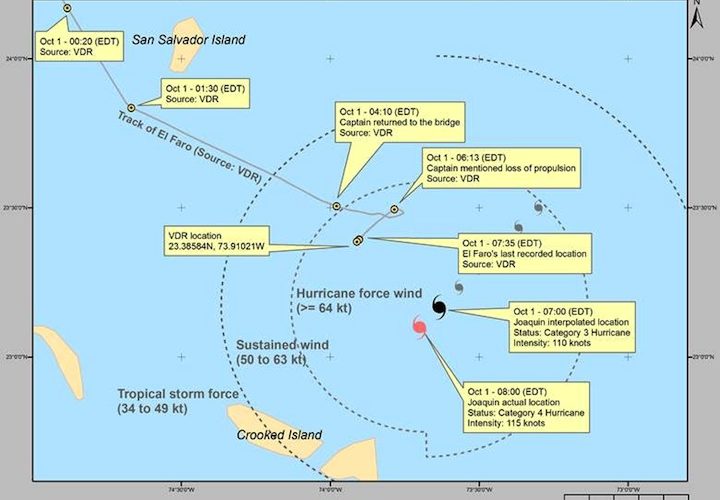The following are excerpts of a news release from the National Transportation Safety Board (NTSB):
(WASHINGTON) — The transcript from El Faro’s voyage data recorder bridge audio was one of five factual reports added Tuesday to the NTSB’s El Faro investigation docket as part of the agency’s ongoing investigation into the maritime tragedy.
Entered into the docket were factual reports from the Electronic Data Group, Meteorology Group, Survival Factors Group, Engineering Group and the Voyage Data Recorder Audio Transcript Group.
The Voyage Data Recorder Audio Transcript Group factual report contains the transcript of the discernable and relevant bridge audio captured by the VDR. Members of the group included the NTSB, the U.S. Coast Guard and Tote Services, the owner of El Faro.
The NTSB considers the information captured in the VDR’s bridge audio recording critical to determining the events leading up to the loss of El Faro. The bridge audio was characterized as “poor quality” and contains high levels of background noise; however, this is not considered unusual. There were six microphones positioned throughout El Faro’s bridge. Extensive digital audio filtering was necessary to enhance the audio. The entire 26-hour recording was reviewed many times, with some statements reviewed more than 100 times by the VDR Audio Transcript Group to ensure they understood what was being said in the recording. About 10 hours of audio was determined to be relevant to the investigation and therefore transcribed by the VDR Audio Transcript Group. The transcript required more than 1,100 work hours to complete. The transcript report is more than 500 pages and is the longest transcript ever produced by the NTSB.
The following is a summary of the characterization of the bridge audio transcript.
The bridge audio recording began about 5:37 a.m., Sept. 30, 2015, roughly eight hours after El Faro departed Jacksonville, Fla.
The first recorded conversation about the forecasted weather was captured the morning of Sept. 30, between the captain and chief mate, who agreed on a course diversion they believed would keep them sufficiently clear of the eye of Hurricane Joaquin. There were multiple conversations regarding weather and route planning throughout the day and evening of Sept. 30.
The captain departed the bridge at about 8 p.m. Sept. 30, and returned at about 4:10 a.m. Oct 1. At about 4:37 a.m. the chief mate received a phone call from the chief engineer regarding the vessel’s list and engine oil levels. This appears to be the first recorded conversation about these issues. The information was related to the captain. The alternate chief engineer is heard stating at about 5:12 a.m. that he’s never seen the ship with such a list.
At about 5:43 a.m. the captain takes a phone call and indicates there is a problem in the No. 3 hold of the ship and sends the chief mate to investigate. They discuss suspected flooding over UHF radio, which appears to be the first recorded conversation about a flooding condition on the ship.
The captain indicates at about 6:13 a.m. that the ship lost propulsion. Numerous conversations are heard throughout the remainder of the recording about the ship’s flooding condition, attempts to rectify the ship’s list and attempts to regain propulsion.
The second mate began formatting a GMDSS distress message at about 6:32 a.m. as directed by the captain. At 7:07 a.m. the captain notified Tote Service’s designated shoreside representative of the critical situation and that he was preparing to send an electronic distress signal. The captain instructed the second mate to send the distress message at about 7:13 a.m. The captain gave the command to sound the ship’s general alarm at about 7:27 a.m. and about two minutes later the second mate exclaimed there were containers in the water and the captain gave the command to sound the abandon ship alarm. About four minutes later the captain relayed over the UHF radio to put the life rafts in the water.
The bridge audio recording ended at about 7:40 a.m. Oct. 1, 2015, with the captain and one of the helmsmen still present on the bridge.
The full bridge audio transcript and other factual reports are available online in the docket.
The public docket contains only factual information collected by NTSB investigators. The public docket does not provide analysis, findings, recommendations or probable cause determinations, and as such, no conclusions about how or why an accident occurred should be drawn from the docket. Providing the docket affords the public the opportunity to see what information has been gathered about the accident. Any analysis, findings, recommendations, or probable cause determinations related to the accident will be issued by the NTSB at a later date.

